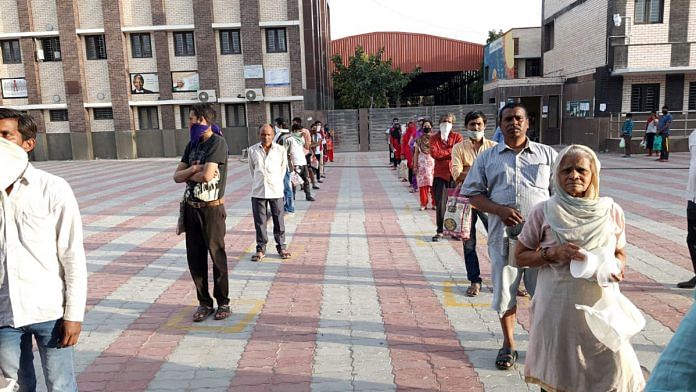New Delhi: Prime Minister Narendra Modi Friday again stressed on the importance of maintaining do gaj ki doori (distance of six feet or nearly 2 metres) in the fight against the Covid pandemic.
Back in April, the PM had underlined the importance of maintaining 2m of social distance thrice in four days.
But India, like several other countries, has diverged from the recommendations for physical distancing made by the World Health Organization (WHO). The WHO recommended a minimum distance of 1m (3 feet) to limit the spread of the infection through liquid droplets that come out when people talk, cough or sneeze.
Additionally, WHO also made an effort to use the phrase ‘physical distancing’ instead of ‘social distancing’, as the latter may imply “disconnect[ing] from our loved ones, from our family”.
ThePrint now takes a look at how social distancing rules vary across countries and the science behind the measure.
Also read: Can Starbucks be Starbucks with social distancing? We’ll adapt, says CEO
1.5m in Canada, ‘1m plus’ in UK, 1m in Singapore
At the most stringent level, Canada has prescribed 2m of physical distancing rule. Switzerland recently reduced its 2m rule to 1.5m as it eased lockdown restrictions.
On Tuesday, the Boris Johnson-led UK government also opted for 2m physical distancing rule before announcing that a “1m plus” rule will begin from 4 July onward. This allows people to maintain 1m distance from each other so long as other measures, such as wearing a mask, are in place.
In a report in The Independent, trade association UKHospitality estimated that establishments would have obtained only 30 per cent of regular revenues under a 2m rule, but 60-75 per cent of revenues will be possible with the new rule.
In a study by medical journal The Lancet, scientists estimated that within the 1m distance, a person has a 13 per cent risk of being infected, but only 3 per cent beyond that distance. Also, for every extra metre of distance of up to 3m, the risk is reduced by half.
The WHO’s recommendation of 1m has been maintained by China, Denmark, France, Hong Kong and Singapore, and people can either choose to, or are required to, wear face masks in public spaces.
In Singapore, not following the 1m rule in “non-transient” interactions can warrant a fine of up to 10,000 Singapore dollars or land one in jail for up to six months, or even both.
Meanwhile, Australia, Belgium, Greece, Germany, Italy, Spain, and Portugal have prescribed 1.5m of physical distance rule, while the US and South Korea have opted for specific distances of 1.8m and 1.4m, respectively.
Some countries have even opted for creative ways to implement physical distancing.
For example, students in a school in China’s Zhejiang have started wearing one-metre hats made using sticks, card boards and even balloons.
In India, Aam Aadmi Party leader Somnath Bharti claims to have encouraged people in his constituency, Malviya Nagar, to venture out with an umbrella in order to practise physical distancing.
“Though not every person in my constituency is following it, I see a good number of people using umbrellas to maintain physical distancing. Think about it. Most umbrellas have a radius of three feet, which automatically enables 6 feet distance from others,” Bharti told ThePrint.
Also read: Social distancing is best option against COVID-19 for now, not forever
Flouting norms
Whether it’s 1m or 2m, physical distancing norms are being flouted across the world.
The celebration of Rath Yatra in Odisha was criticised as the procession saw a sizeable crowd. A similar festival, rathotsavam, was held in Andhra Pradesh the week before PM Modi announced the nationwide lockdown on 24 March.
Recently, UK Health Secretary Matt Hancock warned that public spaces could be closed after people were found flouting Covid-prevention norms and crowding on beaches.
In April, Americans took to the streets in protest against lockdown orders, saying they violated their civil liberties. At the time, the US had over 7,60,000 active coronavirus cases and many protesters didn’t wear masks or follow physical distancing.
Protesters in the recent Black Lives Matter movement also did not follow the prescribed norms, but many wore masks. However, it was also observed that there was no significant increase in Covid-19 cases following these protests.
Pro-democracy protesters in Hong Kong also violated physical distancing norms.
Also read: Interspecies social distancing — we need to give nature some space to save biodiversity
Physical distancing can’t be seen in isolation
In addition to The Lancet study on the efficacy of different physical distancing rules, editor-in-chief of the medical journal, Richard Horton, stressed physical distancing could not be seen in isolation.
“The debate about 1 metre or 2 metres is missing the point. What matters is combination prevention — physical distancing (minimum 1 metre, more if you can), hand washing, respiratory hygiene, face masks in enclosed spaces, and avoid mass gatherings. 2 metres is no magic bullet,” he said in a tweet last week.
The debate about 1 metre or 2 metres is missing the point. What matters is combination prevention—physical distancing (minimum 1 metre, more if you can), hand washing, respiratory hygiene, face masks in enclosed spaces, and avoid mass gatherings. 2 metres is no magic bullet.
— richard horton (@richardhorton1) June 16, 2020
President of the Public Health Foundation of India, Srinath Reddy, agreed with Horton.
“1m distance is not a lakshman rekha. Water droplets can travel to 1.5m and in rare cases, to 2m and with a strong enough air current, some droplets can even travel upto 3m. Therefore, physical distancing has to go hand-in-hand with wearing a mask, so that we have multiple layers of protection,” he told ThePrint.
Switzerland’s health ministry had found that chances of infection are higher “in circumstances in which a particularly large number of droplets are expelled, such as when singing or speaking loudly”.
Also read: ‘Social Bubbles’ can limit coronavirus better than social distancing, Oxford study says



